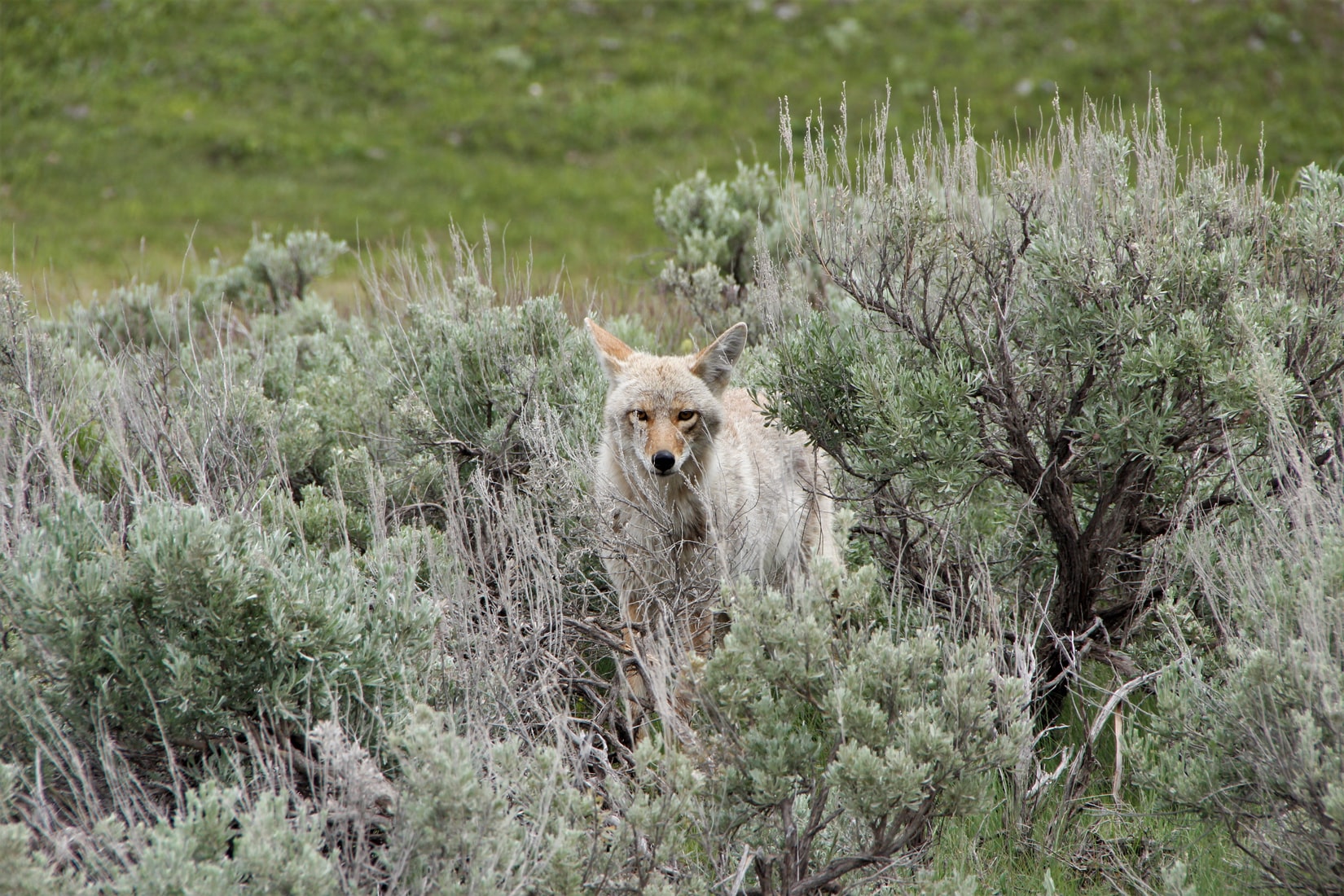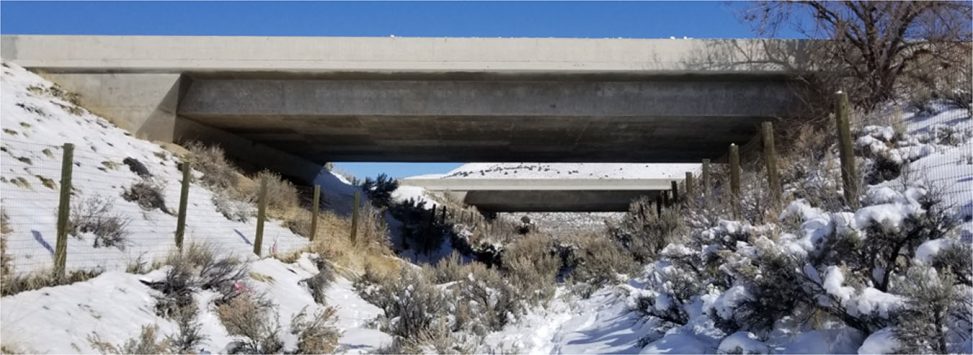
One of the 3 highway underpasses studied in California. February 2019.
Researchers from the California Department of Fish and Wildlife have recently published a study in the Journal of Wildlife Management which seeks to quantify the effects of predator-prey interactions and human disturbances on wildlife utilizing highway underpasses. Highway underpasses are a commonly used wildlife crossing structure which have been used increasingly to enable wildlife to safely traverse busy roadways.
Roads pose a significant hazard for many wildlife populations. In the United States alone, the cost of wildlife-vehicle collisions has been estimated to be 8.4 billion dollars per year. Wildlife crossings such as underpasses act to reduce the number and cost of incidents. Additionally, roads act as barriers to movement which can alter species’ migration, dispersal, and levels of gene flow between populations.
While underpasses and other wildlife crossings seek to address these problems, the impact of the passage must be assessed on the community level. Understanding the role that location of the underpass, the changing seasons, and the implications of human presence in underpasses play are all essential to the application of future wildlife crossings.

coyote, Yellowstone National Park
This study focused on three underpasses located along US Route 385 in California. Since their construction in the mid-1970s, these underpasses have been well-utilized over nearly 40 years by a variety of species including mule deer, rodents, California quail, bobcats, mountain lions, and coyotes. Researchers sought to determine the effects of location, time of day, season, human presence, and interactions between species on the differential use of the underpass space by the species highlighted.
Using remote infrared cameras, researchers collected data over the course of 18 months across the three study sites. Over this time 3,589 non-duplicate species detections were catalogued, with the primary species being mule deer, rodents, lagomorphs (rabbits and hares), and coyotes. The results of this study have confirmed that species interactions and human disturbances play a significant role in the timing and use of these highway underpasses.
Species such as mule deer and rodents were photographed using the underpasses more in the spring and less in the winter compared to fall, whereas the California quail made use of the underpasses primarily in the summer months. These seasonal usage patterns of prey species correlated with increased predator presence. Mountain lions and coyotes both were documented to make less use of the underpasses during the fall and winter months, indicating a potential connection between the presence of predator species and migratory patterns of prey.
Human usage of the underpass space was also shown to be a factor of interest in wildlife presence. Human presence was shown to deter coyotes from making use of the underpasses, while California quail preferred underpasses with higher levels of human disturbance. These results indicated that both predator-prey interactions and human disturbances had an effect on the times at which species utilized the underpasses, as well as which underpasses were preferentially used.
The importance of this research lies in its management application. Managers of highway underpasses and other wildlife thoroughfares must closely monitor their target species to ensure they are not being deterred from using the underpass as a result of predator-prey or human interactions. Wildlife crossings are successful tools in the management of wildlife-vehicle collisions, but only so long as they are adequately monitored and protected to ensure the optimum environment for the species at hand.
References:
Caldwell, M. R., & Klip, J. M. K. (2019). Wildlife Interactions within Highway Underpasses. The Journal of Wildlife Management, 84(2), 227–236. doi: 10.1002/jwmg.21801

Alex
"This title was very eye catching! That is so interesting that such a ..."
Alex
"This is really interesting! The fact that crops and plants are damaged is ..."
Alex
"Well done, this article is great and the information is very captivating! Ethics ..."
Alex
"I was intrigued throughout the whole article! This is such an interesting topic, ..."
Alex
"This is such an interesting article, and very relevant!! Great job at explaining ..."
Grandpa
"Honey You Did a good job I will forward to my eye doctor "
murphymv
"This article is fascinating because it delves into the details of the research ..."
murphymv
"I agree, adding the photo helped solidify the main finding. "
murphymv
"This is a fascinating finding. I hope this innovative approach to improving transplants ..."
Sherzilla
"This is a great article! I would really love to hear how exactly ..."
Sherzilla
"It's disappointment that these treatments were not very effective but hopefully other researchers ..."
Sherzilla
"I agree with your idea that we need to shift our focus to ..."
Sherzilla
"It's amazing to see how such an everyday household product such as ..."
Lauren Kageler
"I will be interested to see what the data looks like from the ..."
Lauren Kageler
"A very interesting article that emphasizes one of the many benefits that the ..."
maricha
"Great post! I had known about the plight of Little Browns, but I ..."
Sherzilla
"I assumed cancer patients were more at risk to the virus but I ..."
Sherzilla
"Great article! It sheds light on a topic that everyone is curious about. ..."
maricha
"This article is full of really important and relevant information! I really liked ..."
maricha
"Definitely a very newsworthy article! Nice job explaining the structure of the virus ..."
maricha
"It's interesting to think that humans aren't only species dealing with the global ..."
murphymv
"This is very interesting and well explained. I am not too familiar with ..."
Lauren Kageler
"Great article! This post is sure to be a useful resource for any ..."
Lauren Kageler
"Definitely seems like an odd pairing at first, but any step forward in ..."
murphymv
"What an interesting article! As you say, height and dementia seem unrelated at ..."
murphymv
"Great article! I learned several new methods of wildlife tracking. This seems like ..."
murphymv
"Very interesting topic! You explained cascade testing and its importance very well. I ..."
Alex
"This article is really interesting! What got me hooked right away was the ..."
Sabrina
"I found this article super interesting! It’s crazy how everyday products can cause ..."
Erin Heeschen
"I love the layout of this article; it's very eyecatching! The advancements of prosthetics ..."
murphymv
"Awesome article! I like the personality in the writing. Flash Graphene not only ..."
murphymv
"Very interesting work! I don't know a whole lot about genetics, but this ..."
Cami Meckley
"I think the idea of using virtual reality technology to better help prepare ..."
Erin Heeschen
"I wonder if there's a connection between tourist season and wildfires in the ..."
Ralph berezan
"Not bad Good work "
Michelle
"This sounds like it would be a great tool for medical students! ..."